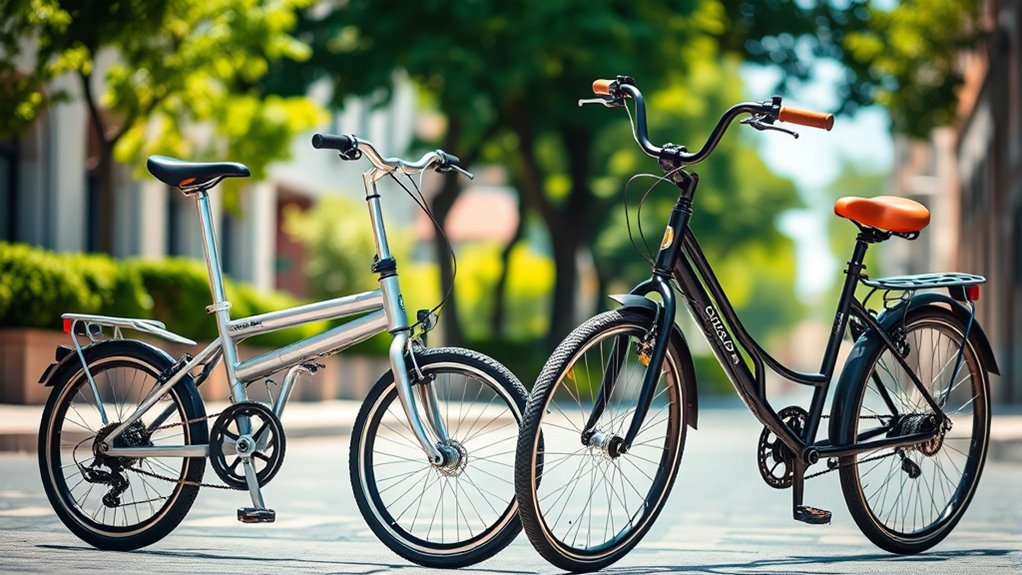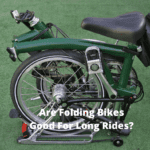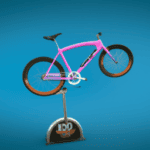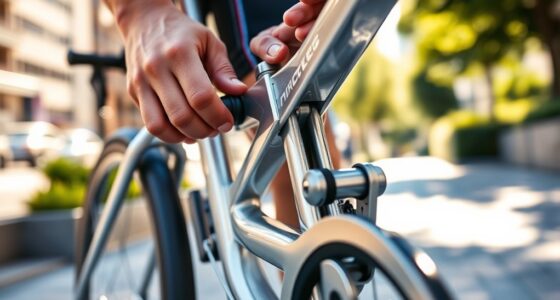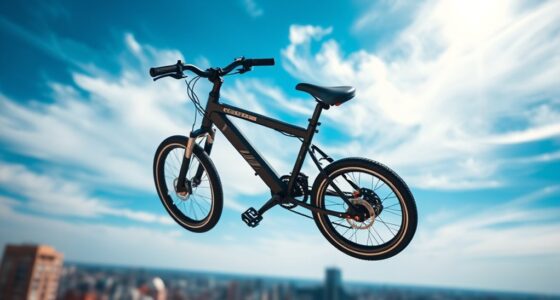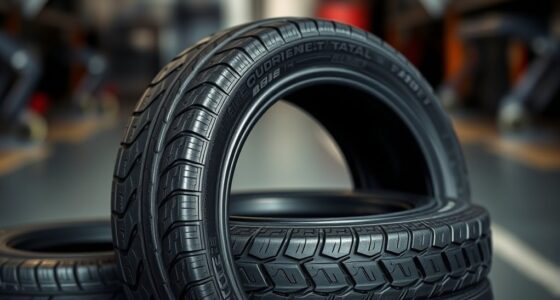Folding bikes are highly portable and perfect for tight spaces, easily collapsing for transport and storage, while traditional bikes offer stability and ride quality with larger frames. Folding bikes tend to be lighter and more versatile for city commuting, but their smaller wheels and hinges can compromise comfort and handling. If you want to understand which bike suits your lifestyle and riding needs best, explore these differences further.
Key Takeaways
- Folding bikes are highly portable, compact, and easy to store, unlike traditional bikes which require more space and have a fixed frame.
- Traditional bikes generally offer better stability, ride comfort, and performance due to larger wheels and solid construction.
- Folding bikes are ideal for urban commuting and multimodal transport; traditional bikes excel in long-distance riding and rough terrains.
- Folding bikes tend to have a higher initial cost but better resale value, while traditional bikes vary widely in price with potentially slower depreciation.
- Folding bikes may have reduced ride quality and durability due to smaller wheels and folding mechanisms, whereas traditional bikes are more durable with fewer flex points.
Portability and Storage Capabilities
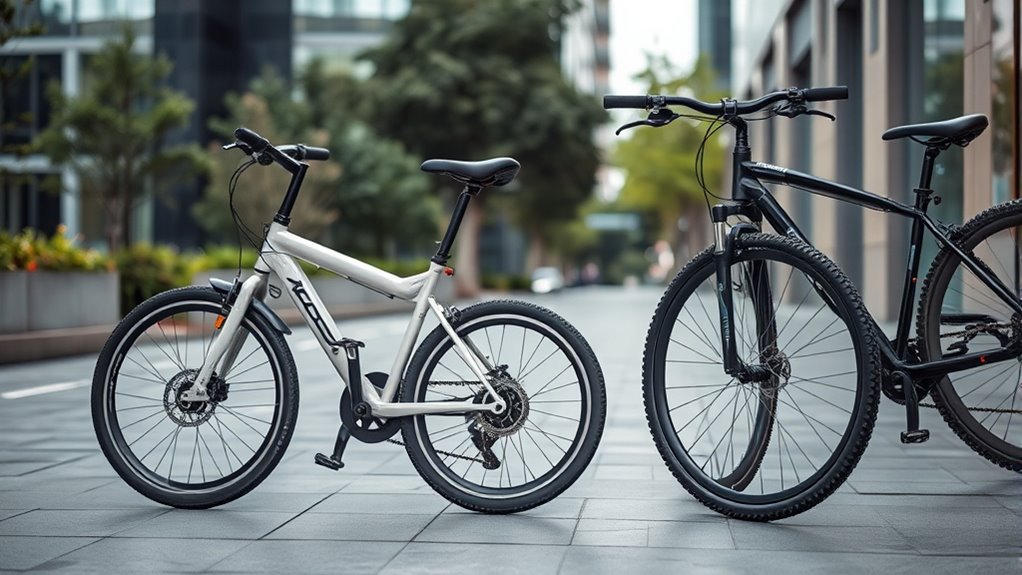
Folding bikes excel in portability and storage because they can be compacted into small sizes, often less than 30 inches when folded. This makes them incredibly easy to store in tight spaces like closets, under desks, or small cabinets. Unlike traditional bikes, which need 5 to 6 feet of space, folding bikes are space-saving and convenient for urban environments. Their compact folded size allows you to carry them onto buses, trains, or store them in your car trunk without hassle. Weighing between 23 to 30 pounds, they are easy to lift and transport, offering enhanced mobility. Their lightweight design and small footprint make folding bikes perfect for those who want quick, effortless storage and on-the-go convenience. Additionally, Kia Tuning upgrades can improve the overall performance and look of bikes that are customized for city commuting. The compact size also makes folding bikes an ideal choice for travelers who need efficient transportation options while on the move. Moreover, understanding the space-saving benefits of folding bikes can help urban commuters make informed decisions about their daily transportation options. For instance, some models feature quick-release mechanisms that facilitate even faster folding and unfolding processes, further enhancing their practicality. Incorporating self-locking systems can also increase safety and ease of use during transportation.
Design and Structural Differences
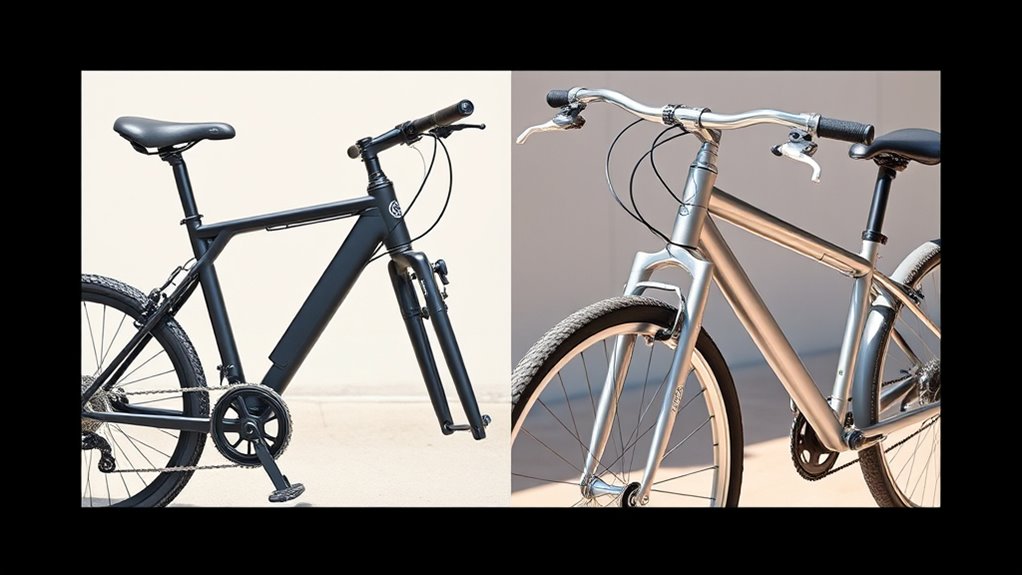
Folding bikes use hinges and quick-release joints that let you collapse the frame for easy storage, unlike traditional bikes with fixed, rigid frames. They often have smaller wheels and lightweight materials like aluminum to keep them portable and easy to handle. In contrast, traditional bikes have solid construction with continuous frames, designed for stability and speed over long distances. Additionally, frame design plays a crucial role in determining a bike’s functionality and suitability for different riding styles. The choice between the two types often depends on the rider’s specific needs and lifestyle, such as commuting or recreational riding, which can be influenced by their lifestyle preferences.
Folding Mechanisms and Devices
Different mechanisms enable folding bikes to compactly collapse for easy storage and transport. The folding mechanism often uses hinges—such as quick-release or ViseGrip hinges—that allow you to fold and unfold the bike quickly. Internal hubs contribute to seamless gear shifting during folding, enhancing convenience. The structural design incorporates specialized joints and locking systems to assure stability and safety when riding, even in segmented frames. Most folding devices are engineered for one- or two-step folding, reducing setup time. The choice of materials—steel, aluminum, or carbon fiber—affects the bike’s weight and durability, influencing portability. When folded, these bikes vary in size, with some small enough for airline overhead compartments and others designed to fit under desks or in cabinets. Additionally, material selection impacts the bike’s overall weight and robustness, making it suitable for different user needs. The folding process itself can be optimized with innovative mechanisms to further simplify setup and storage. Incorporating innovative folding mechanisms can make the process even more user-friendly and efficient. Regional statistics can also influence the popularity and availability of different folding bike models in various areas. Incorporating precious metals, such as those used in some high-end components, can also enhance the durability and value of folding bikes, especially in premium models.
Frame Materials and Construction
When it comes to frame materials and construction, the choices considerably influence a bike’s weight, strength, and portability. Folding bikes often use lightweight materials like aluminum, steel, or carbon fiber to keep them easy to carry. Aluminum frames are popular for their lightness, while steel frames, especially brazed steel, offer durability and strength. Premium models may incorporate carbon fiber components to reduce weight further. The frame construction involves hinges, quick-release clasps, and reinforced joints that enable folding without sacrificing structural integrity. Frame geometry in folding bikes emphasizes portability, with smaller tube diameters and reinforced hinges, unlike traditional bikes designed for maximum stiffness and stability. Overall, the selection of frame materials directly impacts how a folding bike balances durability, weight, and ease of transport. Additionally, understanding the material properties helps in choosing a bike that best fits your needs for durability and performance. The manufacturing techniques used in assembling these frames also play a crucial role in their overall quality and longevity. Moreover, the performance characteristics resulting from different materials influence how well a bike performs in various riding conditions. Considering the cost implications of different frame materials can also help in making a more informed purchase decision. Recognizing the cultural significance of certain materials, such as steel in vintage bikes, can also influence your choice based on personal or aesthetic preferences.
Ride Comfort and Handling
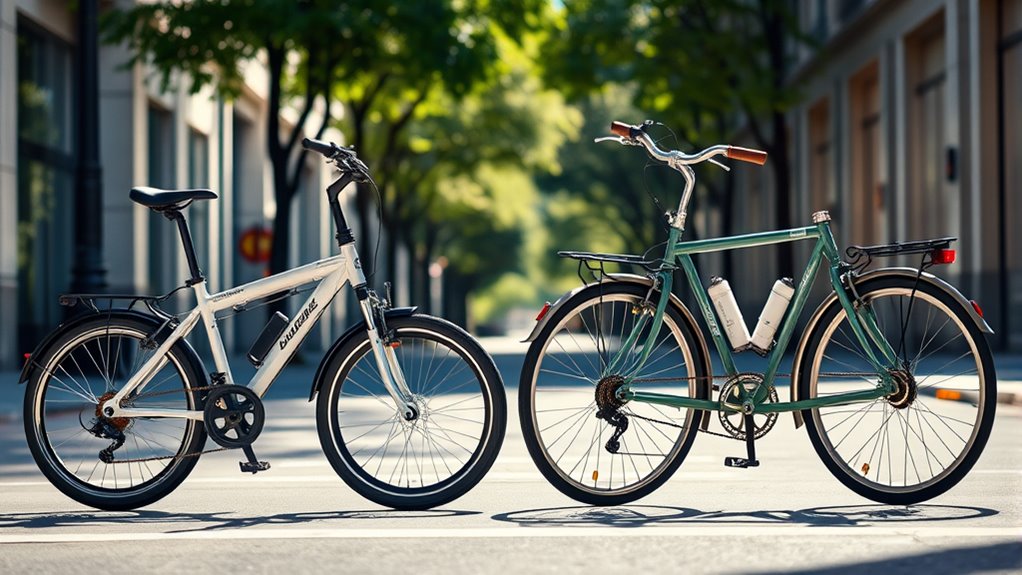
While folding bikes are designed for portability, their ride comfort and handling often fall short of traditional bikes. Smaller wheel sizes (16-20 inches) contribute to a bumpier ride and less stability compared to larger wheels (24-29 inches). The compact, upright frame geometry reduces handling precision at higher speeds and impacts ride performance. The folding mechanisms and hinges can introduce flex, decreasing frame rigidity and ride quality. These factors compromise shock absorption and overall stability during rides. To visualize, consider this comparison:
| Feature | Folding Bike | Traditional Bike | Impact on Ride |
|---|---|---|---|
| Wheel Size | 16-20 inches | 24-29 inches | Bumpier, less stable |
| Frame Geometry | Upright, compact | Longer, aerodynamic | Reduced handling, comfort |
| Frame Rigidity | Flexible hinges, less stiff | Solid, more rigid | Smoother ride, better control |
| Ride Quality | Lower, less shock absorption | Superior shock absorption | Enhanced comfort and stability |
Additionally, advancements in Volkswagen Tuning have shown that improving component rigidity, such as upgrading suspension parts, can significantly enhance ride quality, a principle that also applies to bicycle design. Furthermore, ongoing research indicates that the integration of advanced materials can lead to lighter, more durable frames, positively affecting ride performance. Proper tire selection and inflation also play a crucial role in ride comfort, highlighting the importance of overall bike setup. Moreover, understanding appliance integration concepts in smart homes can inspire innovative solutions for ergonomic bike design, leading to better rider experiences.
Versatility and Use Cases
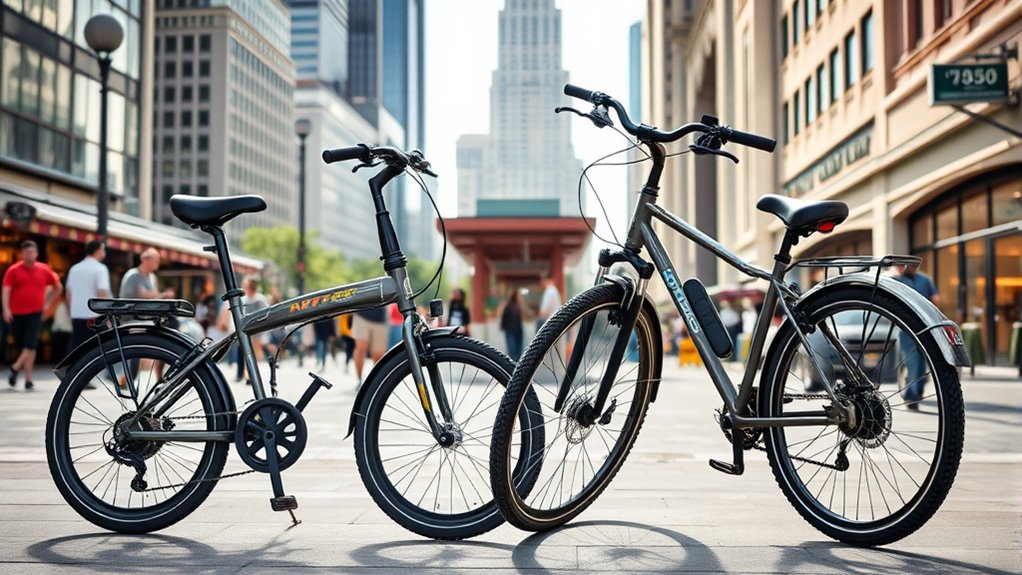
Folding bikes are incredibly versatile, especially in urban environments where space and convenience matter most. Their compact size makes storage easy in small apartments, offices, or car trunks, unlike traditional bikes that require more room. They excel in multimodal commuting, allowing you to seamlessly combine riding with public transportation or car travel. Whether you’re running quick errands or heading to work, folding bikes adapt to various scenarios, offering unmatched convenience. They’re perfect for short trips, city commuting, and storage in tight spaces. While not ideal for long-distance rides or rough terrains, their versatility shines in congested urban settings and complex travel routes. If you need a flexible, portable bike that fits into busy city life, folding bikes are your best option.
Cost and Investment Value
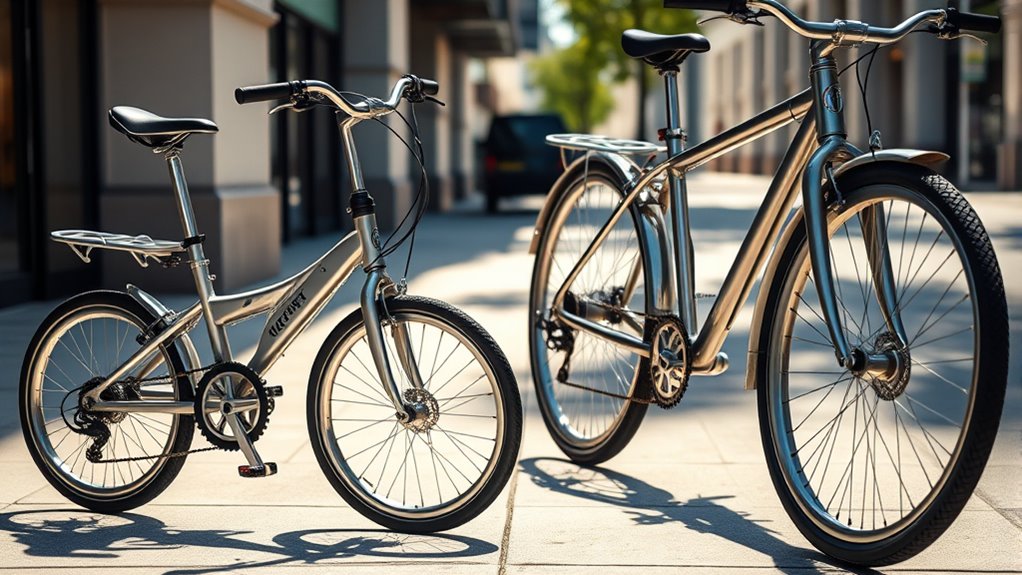
When considering cost, folding bikes typically have a higher starting price than basic traditional bikes, but they often save you money over time through reduced storage and theft risks. You’ll find that high-end models can be quite expensive, yet they hold their resale value well, especially brands like Brompton. Ultimately, your choice depends on how you value initial investment versus long-term savings and durability.
Price Range Variability
Have you noticed how much the price range varies between folding and traditional bikes? The cost variability is significant, with budget folding models starting around £300 ($400) and high-end options like Brompton costing about £1,250 ($1,600). Premium folding bikes with lightweight materials, advanced features, and electric assist can be two to three times more expensive than basic traditional bikes, which often cost under $300 but can exceed $10,000 for specialized models. The overall weight, materials used—such as carbon fiber versus steel or aluminum—and added features heavily influence the price. When comparing costs, consider that traditional bikes generally have a narrower range, but premium models can be costly. This cost comparison highlights how the initial investment varies widely based on features and quality.
Resale and Long-term Value
Because of their high build quality and brand reputation, folding bikes like Brompton often hold their value well, with many used models selling for 70-80% of their original price. Their durability and popularity in urban settings make them a smart long-term investment. Traditional bikes from reputable brands tend to depreciate more slowly and may even appreciate if they are vintage or collectible. Lower-cost folding bikes, however, often experience faster depreciation due to lower build quality and less recognition, reducing their resale value. Proper maintenance can further enhance your bike’s resale price.
| Bike Type | Resale Value | Long-term Investment | Key Factors |
|---|---|---|---|
| Folding Bikes (Brompton) | High (70-80%) | Strong | Build quality, brand reputation |
| Traditional Bikes | Slow depreciation | Variable | Vintage appeal, maintenance |
| Low-cost Folding Bikes | Faster depreciation | Limited | Build quality, recognition |
| Used Bikes | Varies | Depends on condition | Maintenance, rarity |
Performance and Durability

Folding bikes generally offer less performance and durability than traditional bikes due to their smaller wheels, lighter frames, and complex folding mechanisms. Smaller wheels reduce stability and ride quality, especially at high speeds or over long distances. The frame’s design and materials, often steel or aluminum, compromise rigidity, making power transfer less efficient and decreasing overall durability. Folding hinges and joints require more maintenance and tend to wear out faster, limiting the bike’s lifespan. Traditional bikes, constructed with advanced materials like carbon fiber and alloys, provide superior strength and longevity, making them better suited for high-speed, long-distance rides or rugged terrain. While folding bikes excel in portability, they typically don’t match the durability and performance of traditional models.
Suitability for Different Environments
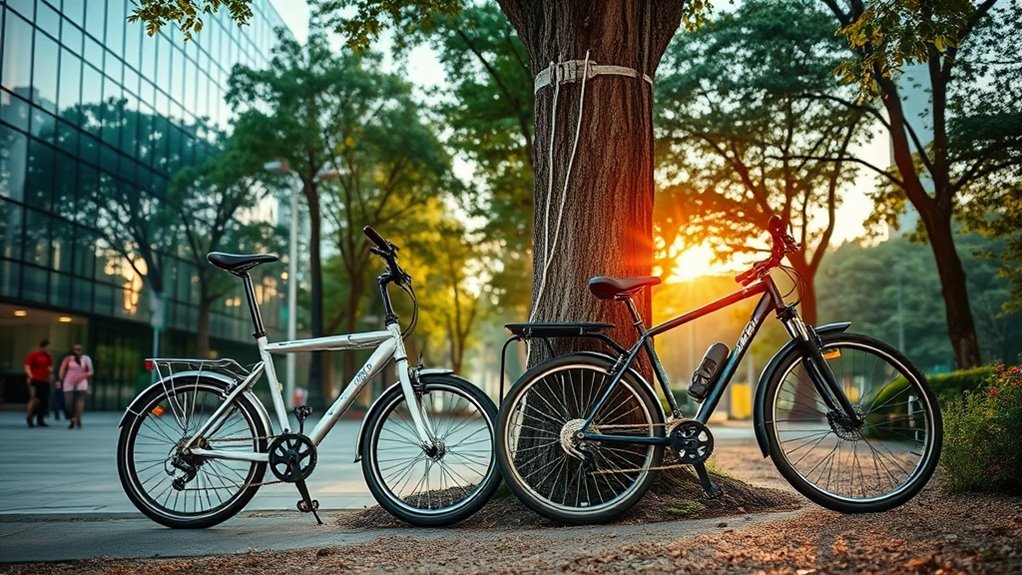
Folding bikes are especially well-suited for urban environments where space is limited and transportation options are multiple. Their compact size makes maneuvering city streets easier, especially in crowded areas. Consider these key points:
- They fit easily into small apartments, offices, or public transport compartments, saving storage space.
- Ideal for multi-modal commutes, you can take them on trains, buses, or store them in car trunks without hassle.
- They excel in urban environments but are less suited for rugged terrain or off-road adventures.
- Traditional bikes outperform folding bikes on off-road terrains, providing better stability, ride comfort, and durability on rough or uneven surfaces.
If your focus is on city streets and tight spaces, folding bikes are the perfect choice; for rugged terrain, traditional bikes are better.
Frequently Asked Questions
Are Folding Bikes as Good as Normal Bikes?
You’re wondering if folding bikes are as good as normal bikes. While folding bikes excel in portability and storage, they often have smaller wheels and less rigid frames, leading to a bumpier ride and less stability. If your main goal is easy transport and space-saving, they’re great. But for comfort, performance, and long-distance riding, traditional bikes usually outperform folding bikes. Choose based on your specific needs and riding style.
What Is the Disadvantage of a Folding Bike?
You might think folding bikes are perfect for convenience, but their main disadvantage is ride quality. Smaller wheels often lead to a bumpier, less stable ride on rough surfaces. The folding mechanisms and lightweight materials can reduce durability and stiffness, making them less suitable for long rides or challenging terrains. Plus, their limited gear range and complex maintenance needs can hinder performance compared to traditional bikes.
What Are the Advantages of a Folding Bike?
You’ll find that folding bikes offer great advantages, especially if you value portability and convenience. They’re easy to carry, store, and transport, fitting into small spaces like closets or car trunks. Their quick folding mechanisms make multi-modal commuting seamless, saving you time. Plus, they’re lightweight, so you can carry them easily, and many are airline-compatible, perfect for travel. Overall, folding bikes make urban commuting flexible and hassle-free.
Is It Harder to Pedal a Folding Bike?
Think of riding a folding bike like pushing a small boat through choppy waters—smaller wheels and flexible frames mean you need more effort, especially on uneven terrain. You might notice it feels a bit harder to pedal because of reduced stability and power transfer. While lightweight materials help, the compact design’s added weight and complex folding parts can make pedaling feel like a tougher climb, compared to traditional bikes.
Conclusion
When choosing between folding bikes and traditional bikes, consider how you ride and store your bike. Did you know that over 60% of urban cyclists prefer folding bikes for their portability? If space and convenience matter most, a folding bike might be your best bet. However, for long-distance rides, a traditional bike could offer better comfort and performance. Ultimately, pick the one that best fits your lifestyle and needs.
